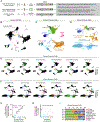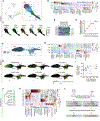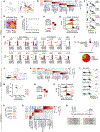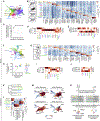Single-Cell Transcriptomics of Human and Mouse Lung Cancers Reveals Conserved Myeloid Populations across Individuals and Species
- PMID: 30979687
- PMCID: PMC6620049
- DOI: 10.1016/j.immuni.2019.03.009
Single-Cell Transcriptomics of Human and Mouse Lung Cancers Reveals Conserved Myeloid Populations across Individuals and Species
Abstract
Tumor-infiltrating myeloid cells (TIMs) comprise monocytes, macrophages, dendritic cells, and neutrophils, and have emerged as key regulators of cancer growth. These cells can diversify into a spectrum of states, which might promote or limit tumor outgrowth but remain poorly understood. Here, we used single-cell RNA sequencing (scRNA-seq) to map TIMs in non-small-cell lung cancer patients. We uncovered 25 TIM states, most of which were reproducibly found across patients. To facilitate translational research of these populations, we also profiled TIMs in mice. In comparing TIMs across species, we identified a near-complete congruence of population structures among dendritic cells and monocytes; conserved neutrophil subsets; and species differences among macrophages. By contrast, myeloid cell population structures in patients' blood showed limited overlap with those of TIMs. This study determines the lung TIM landscape and sets the stage for future investigations into the potential of TIMs as immunotherapy targets.
Keywords: dendritic cell heterogeneity; macrophage heterogeneity; mouse-human comparison; myeloid cells; neutrophil heterogeneity; single-cell analysis; tumor immunology; tumor microenvironment.
Copyright © 2019 Elsevier Inc. All rights reserved.
Conflict of interest statement
Declaration of Interests
M.J.P. has served as a consultant for Aileron Therapeutics, Cygnal Therapeutics, Elstar Therapeutics, KSQ Therapeutics and Siamab Therapeutics; these commercial relationships are unrelated to the current study. AMK is a founder and shareholder in 1CellBio, Inc.
Figures







References
-
- Ardouin L, Luche H, Chelbi R, Carpentier S, Shawket A, Montanana Sanchis F, Santa Maria C, Grenot P, Alexandre Y, Gregoire C, et al. (2016). Broad and Largely Concordant Molecular Changes Characterize Tolerogenic and Immunogenic Dendritic Cell Maturation in Thymus and Periphery. Immunity 45, 305–318. - PubMed
-
- Bogaert DJ, Dullaers M, Lambrecht BN, Vermaelen KY, De Baere E, and Haerynck F (2016). Genes associated with common variable immunodeficiency: one diagnosis to rule them all? J Med Genet 53, 575–590. - PubMed
Publication types
MeSH terms
Grants and funding
LinkOut - more resources
Full Text Sources
Other Literature Sources
Medical
Molecular Biology Databases

